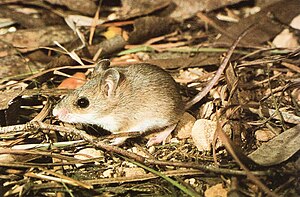Little Australian mouse
| Little Australian mouse | ||||||||||||
|---|---|---|---|---|---|---|---|---|---|---|---|---|

Little Australian mouse ( Pseudomys delicatus ) |
||||||||||||
| Systematics | ||||||||||||
|
||||||||||||
| Scientific name | ||||||||||||
| Pseudomys delicatulus | ||||||||||||
| ( Gould , 1842) |
The Australian little mouse ( Pseudomys delicatulus ) is a rodent in the genus of Australian mice .
features
With a head-trunk length of 55 to 75 mm, a tail length of 55 to 80 mm and a weight of 6 to 15 g, the species is one of the smallest representatives of its genus. It has hind feet 14 to 19 mm long and ears 10 to 12 mm long. On the top, the fur is yellow-brown to gray-brown in color. The border to the cream-colored to white underside is clear.
distribution
The species has two major populations in Australia . The first in the north of Western Australia , in the north of the Northern Territory as well as in the northwest of Queensland . The area of the other population stretches from Cape York Peninsula across east Queensland to northeast New South Wales . A third population occurs in southwest Papua New Guinea . The Australian lesser mouse can also be found on several small Australian islands in the region. Open, sandy areas with scattered grass cover serve as habitats . The species continues to visit savannas with open tree populations that are used intensively for livestock farming.
Way of life
The little Australian mouse digs a more or less complex tunnel system in which it rests during the day. Occasionally there can be up to four specimens in a burrow. The species looks for food on the ground at night, which consists mainly of seeds from grasses and other plants. In addition, fruits, leaves, herb stalks and invertebrates are eaten.
In general, reproduction in northern Australia occurs in the dry season, while most matings in southern Australia occur in spring and summer. In some areas, the mating season depends more on the food available than on the season. Females have several litters per year with 3 to 4 offspring per litter, which are born after about 30 days of gestation . After grass fires, the population in affected areas skyrockets.
Danger
There are no threats to the population. The little Australian mouse is listed as Least Concern by the IUCN .
Individual evidence
- ↑ Don E. Wilson , DeeAnn M. Reeder (Ed.): Mammal Species of the World . A taxonomic and geographic Reference . 3. Edition. 2 volumes. Johns Hopkins University Press, Baltimore MD 2005, ISBN 0-8018-8221-4 (English, Pseudomys delicatulus ).
- ↑ a b c Don E. Wilson, Thomas E. Lacher Jr., Russell A. Mittermeier (eds.): Handbook of the Mammals of the World. Volume 7 - Rodents II . Lynx Edicions, 2017, ISBN 978-84-16728-04-6 , pp. 729 (English).
- ↑ a b c Pseudomys delicatulus in the endangered Red List species the IUCN 2016 Posted by: Burbidge, AA, 2016. Accessed July 5 2020th